GrainCorp Limited: Australian Business Structure and Strategy Analysis
VerifiedAdded on 2021/06/17
|11
|3061
|91
Report
AI Summary
This report provides an in-depth analysis of GrainCorp Limited, an Australian agribusiness company. It examines the company's organizational structure, which is characterized by a lateral design with specialized segments for storage and logistics, marketing, malt production, and oil processing. The report highlights GrainCorp's democratic leadership style, emphasizing communication and employee involvement in decision-making. Furthermore, it explores the company's strategic initiatives, including a focus on its malt and oil segments, international acquisitions, and market differentiation to gain a competitive edge. The report emphasizes the importance of structure and strategies in GrainCorp's success.
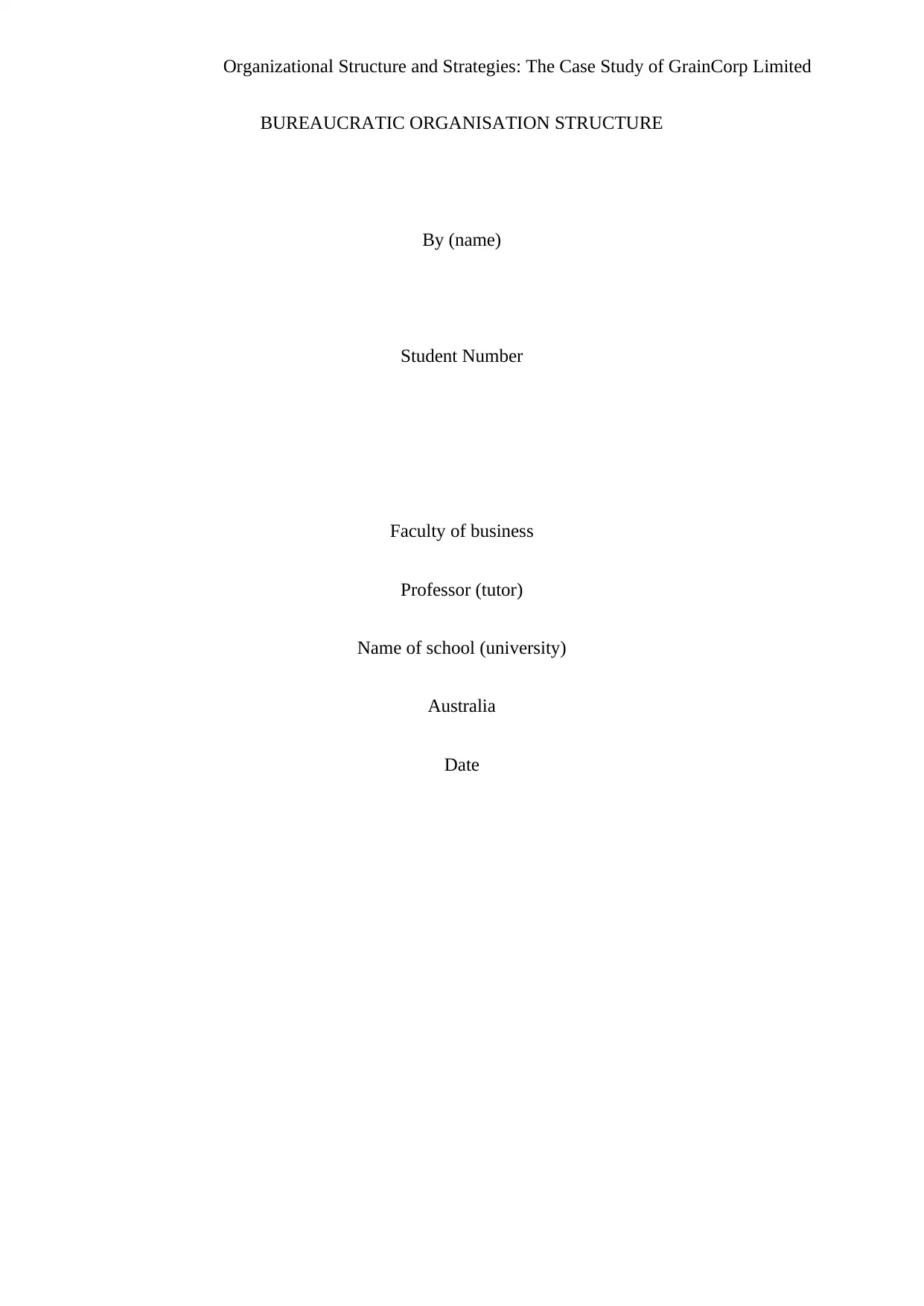
Organizational Structure and Strategies: The Case Study of GrainCorp Limited
BUREAUCRATIC ORGANISATION STRUCTURE
By (name)
Student Number
Faculty of business
Professor (tutor)
Name of school (university)
Australia
Date
BUREAUCRATIC ORGANISATION STRUCTURE
By (name)
Student Number
Faculty of business
Professor (tutor)
Name of school (university)
Australia
Date
Paraphrase This Document
Need a fresh take? Get an instant paraphrase of this document with our AI Paraphraser
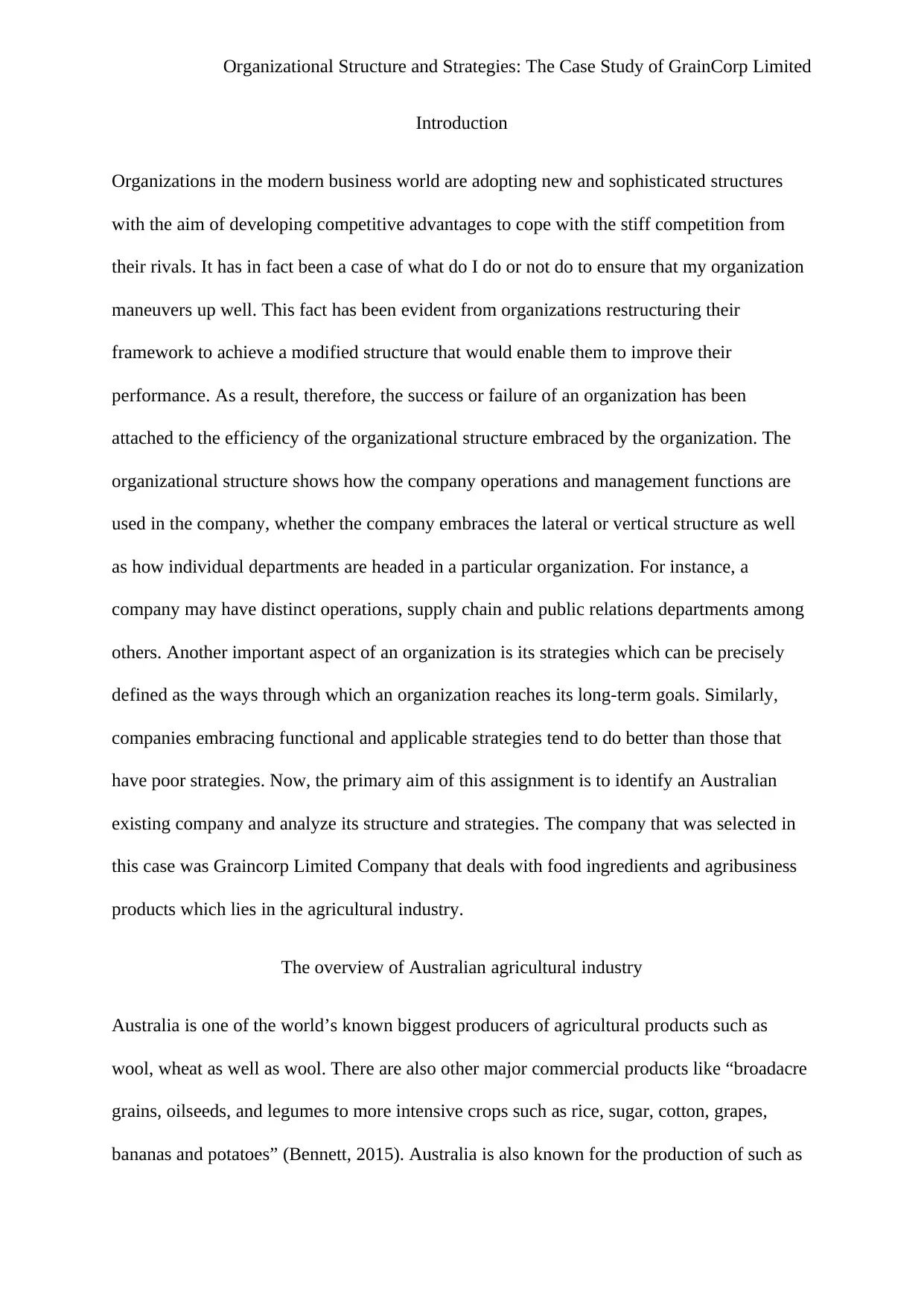
Organizational Structure and Strategies: The Case Study of GrainCorp Limited
Introduction
Organizations in the modern business world are adopting new and sophisticated structures
with the aim of developing competitive advantages to cope with the stiff competition from
their rivals. It has in fact been a case of what do I do or not do to ensure that my organization
maneuvers up well. This fact has been evident from organizations restructuring their
framework to achieve a modified structure that would enable them to improve their
performance. As a result, therefore, the success or failure of an organization has been
attached to the efficiency of the organizational structure embraced by the organization. The
organizational structure shows how the company operations and management functions are
used in the company, whether the company embraces the lateral or vertical structure as well
as how individual departments are headed in a particular organization. For instance, a
company may have distinct operations, supply chain and public relations departments among
others. Another important aspect of an organization is its strategies which can be precisely
defined as the ways through which an organization reaches its long-term goals. Similarly,
companies embracing functional and applicable strategies tend to do better than those that
have poor strategies. Now, the primary aim of this assignment is to identify an Australian
existing company and analyze its structure and strategies. The company that was selected in
this case was Graincorp Limited Company that deals with food ingredients and agribusiness
products which lies in the agricultural industry.
The overview of Australian agricultural industry
Australia is one of the world’s known biggest producers of agricultural products such as
wool, wheat as well as wool. There are also other major commercial products like “broadacre
grains, oilseeds, and legumes to more intensive crops such as rice, sugar, cotton, grapes,
bananas and potatoes” (Bennett, 2015). Australia is also known for the production of such as
Introduction
Organizations in the modern business world are adopting new and sophisticated structures
with the aim of developing competitive advantages to cope with the stiff competition from
their rivals. It has in fact been a case of what do I do or not do to ensure that my organization
maneuvers up well. This fact has been evident from organizations restructuring their
framework to achieve a modified structure that would enable them to improve their
performance. As a result, therefore, the success or failure of an organization has been
attached to the efficiency of the organizational structure embraced by the organization. The
organizational structure shows how the company operations and management functions are
used in the company, whether the company embraces the lateral or vertical structure as well
as how individual departments are headed in a particular organization. For instance, a
company may have distinct operations, supply chain and public relations departments among
others. Another important aspect of an organization is its strategies which can be precisely
defined as the ways through which an organization reaches its long-term goals. Similarly,
companies embracing functional and applicable strategies tend to do better than those that
have poor strategies. Now, the primary aim of this assignment is to identify an Australian
existing company and analyze its structure and strategies. The company that was selected in
this case was Graincorp Limited Company that deals with food ingredients and agribusiness
products which lies in the agricultural industry.
The overview of Australian agricultural industry
Australia is one of the world’s known biggest producers of agricultural products such as
wool, wheat as well as wool. There are also other major commercial products like “broadacre
grains, oilseeds, and legumes to more intensive crops such as rice, sugar, cotton, grapes,
bananas and potatoes” (Bennett, 2015). Australia is also known for the production of such as
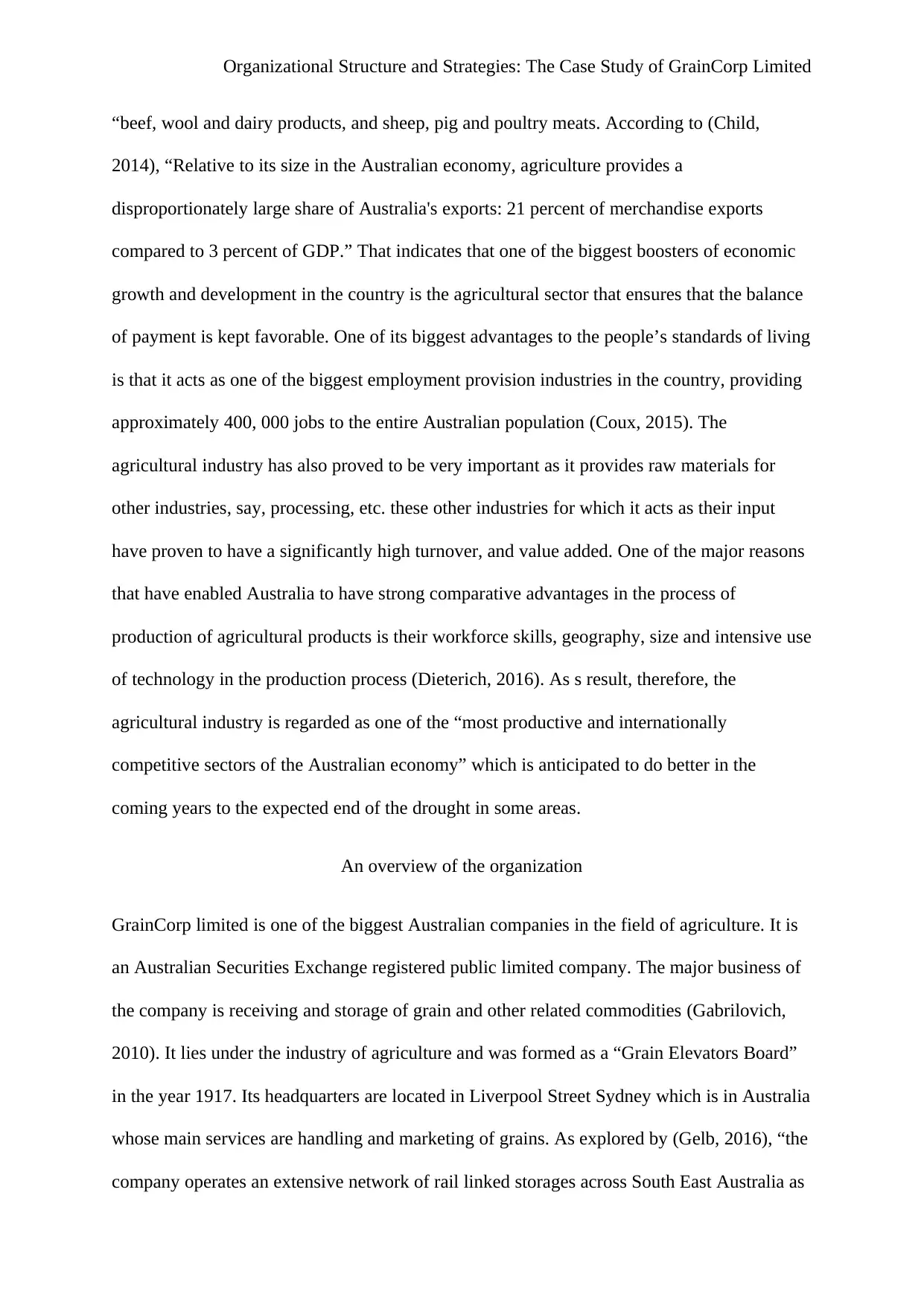
Organizational Structure and Strategies: The Case Study of GrainCorp Limited
“beef, wool and dairy products, and sheep, pig and poultry meats. According to (Child,
2014), “Relative to its size in the Australian economy, agriculture provides a
disproportionately large share of Australia's exports: 21 percent of merchandise exports
compared to 3 percent of GDP.” That indicates that one of the biggest boosters of economic
growth and development in the country is the agricultural sector that ensures that the balance
of payment is kept favorable. One of its biggest advantages to the people’s standards of living
is that it acts as one of the biggest employment provision industries in the country, providing
approximately 400, 000 jobs to the entire Australian population (Coux, 2015). The
agricultural industry has also proved to be very important as it provides raw materials for
other industries, say, processing, etc. these other industries for which it acts as their input
have proven to have a significantly high turnover, and value added. One of the major reasons
that have enabled Australia to have strong comparative advantages in the process of
production of agricultural products is their workforce skills, geography, size and intensive use
of technology in the production process (Dieterich, 2016). As s result, therefore, the
agricultural industry is regarded as one of the “most productive and internationally
competitive sectors of the Australian economy” which is anticipated to do better in the
coming years to the expected end of the drought in some areas.
An overview of the organization
GrainCorp limited is one of the biggest Australian companies in the field of agriculture. It is
an Australian Securities Exchange registered public limited company. The major business of
the company is receiving and storage of grain and other related commodities (Gabrilovich,
2010). It lies under the industry of agriculture and was formed as a “Grain Elevators Board”
in the year 1917. Its headquarters are located in Liverpool Street Sydney which is in Australia
whose main services are handling and marketing of grains. As explored by (Gelb, 2016), “the
company operates an extensive network of rail linked storages across South East Australia as
“beef, wool and dairy products, and sheep, pig and poultry meats. According to (Child,
2014), “Relative to its size in the Australian economy, agriculture provides a
disproportionately large share of Australia's exports: 21 percent of merchandise exports
compared to 3 percent of GDP.” That indicates that one of the biggest boosters of economic
growth and development in the country is the agricultural sector that ensures that the balance
of payment is kept favorable. One of its biggest advantages to the people’s standards of living
is that it acts as one of the biggest employment provision industries in the country, providing
approximately 400, 000 jobs to the entire Australian population (Coux, 2015). The
agricultural industry has also proved to be very important as it provides raw materials for
other industries, say, processing, etc. these other industries for which it acts as their input
have proven to have a significantly high turnover, and value added. One of the major reasons
that have enabled Australia to have strong comparative advantages in the process of
production of agricultural products is their workforce skills, geography, size and intensive use
of technology in the production process (Dieterich, 2016). As s result, therefore, the
agricultural industry is regarded as one of the “most productive and internationally
competitive sectors of the Australian economy” which is anticipated to do better in the
coming years to the expected end of the drought in some areas.
An overview of the organization
GrainCorp limited is one of the biggest Australian companies in the field of agriculture. It is
an Australian Securities Exchange registered public limited company. The major business of
the company is receiving and storage of grain and other related commodities (Gabrilovich,
2010). It lies under the industry of agriculture and was formed as a “Grain Elevators Board”
in the year 1917. Its headquarters are located in Liverpool Street Sydney which is in Australia
whose main services are handling and marketing of grains. As explored by (Gelb, 2016), “the
company operates an extensive network of rail linked storages across South East Australia as
⊘ This is a preview!⊘
Do you want full access?
Subscribe today to unlock all pages.

Trusted by 1+ million students worldwide
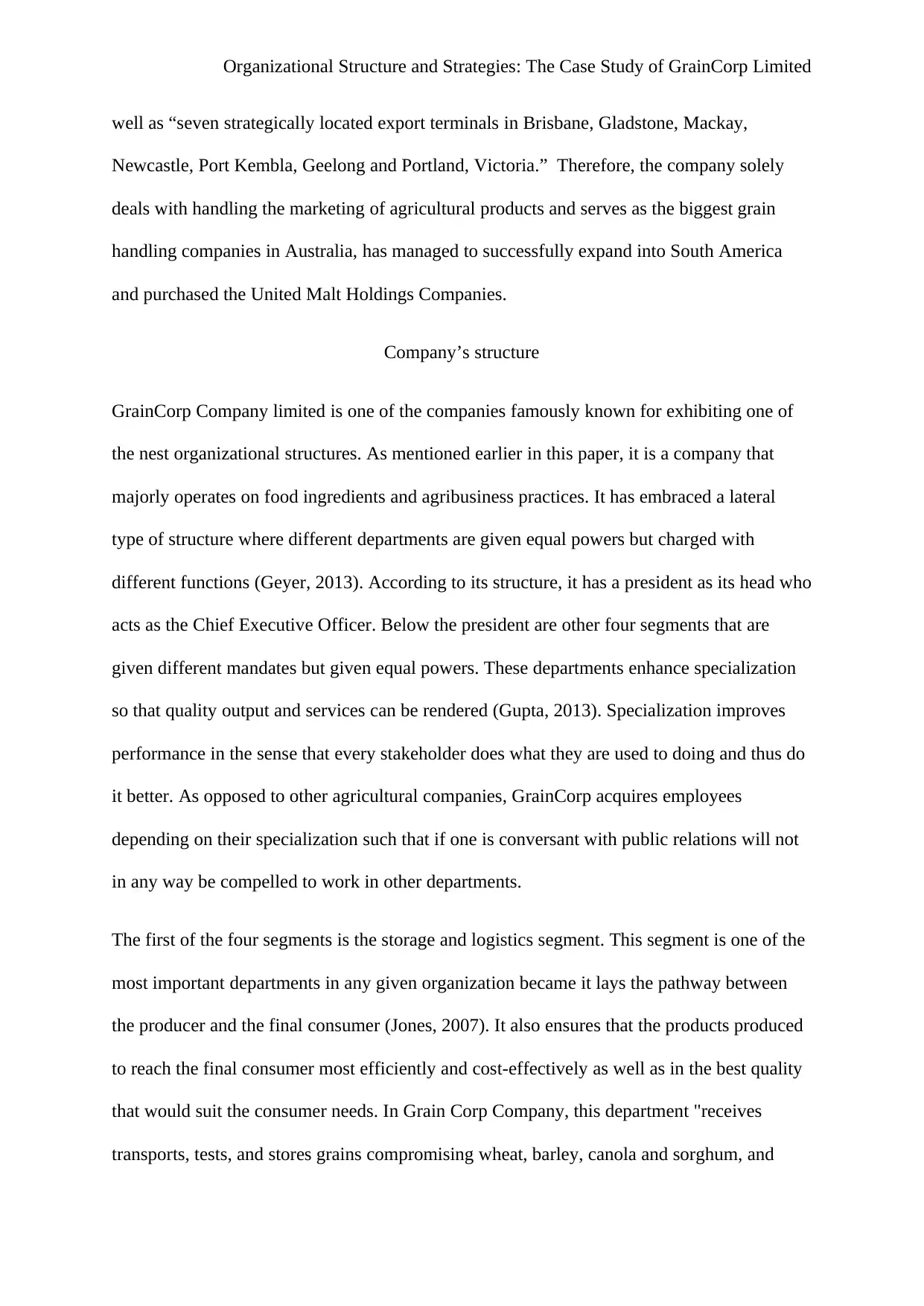
Organizational Structure and Strategies: The Case Study of GrainCorp Limited
well as “seven strategically located export terminals in Brisbane, Gladstone, Mackay,
Newcastle, Port Kembla, Geelong and Portland, Victoria.” Therefore, the company solely
deals with handling the marketing of agricultural products and serves as the biggest grain
handling companies in Australia, has managed to successfully expand into South America
and purchased the United Malt Holdings Companies.
Company’s structure
GrainCorp Company limited is one of the companies famously known for exhibiting one of
the nest organizational structures. As mentioned earlier in this paper, it is a company that
majorly operates on food ingredients and agribusiness practices. It has embraced a lateral
type of structure where different departments are given equal powers but charged with
different functions (Geyer, 2013). According to its structure, it has a president as its head who
acts as the Chief Executive Officer. Below the president are other four segments that are
given different mandates but given equal powers. These departments enhance specialization
so that quality output and services can be rendered (Gupta, 2013). Specialization improves
performance in the sense that every stakeholder does what they are used to doing and thus do
it better. As opposed to other agricultural companies, GrainCorp acquires employees
depending on their specialization such that if one is conversant with public relations will not
in any way be compelled to work in other departments.
The first of the four segments is the storage and logistics segment. This segment is one of the
most important departments in any given organization became it lays the pathway between
the producer and the final consumer (Jones, 2007). It also ensures that the products produced
to reach the final consumer most efficiently and cost-effectively as well as in the best quality
that would suit the consumer needs. In Grain Corp Company, this department "receives
transports, tests, and stores grains compromising wheat, barley, canola and sorghum, and
well as “seven strategically located export terminals in Brisbane, Gladstone, Mackay,
Newcastle, Port Kembla, Geelong and Portland, Victoria.” Therefore, the company solely
deals with handling the marketing of agricultural products and serves as the biggest grain
handling companies in Australia, has managed to successfully expand into South America
and purchased the United Malt Holdings Companies.
Company’s structure
GrainCorp Company limited is one of the companies famously known for exhibiting one of
the nest organizational structures. As mentioned earlier in this paper, it is a company that
majorly operates on food ingredients and agribusiness practices. It has embraced a lateral
type of structure where different departments are given equal powers but charged with
different functions (Geyer, 2013). According to its structure, it has a president as its head who
acts as the Chief Executive Officer. Below the president are other four segments that are
given different mandates but given equal powers. These departments enhance specialization
so that quality output and services can be rendered (Gupta, 2013). Specialization improves
performance in the sense that every stakeholder does what they are used to doing and thus do
it better. As opposed to other agricultural companies, GrainCorp acquires employees
depending on their specialization such that if one is conversant with public relations will not
in any way be compelled to work in other departments.
The first of the four segments is the storage and logistics segment. This segment is one of the
most important departments in any given organization became it lays the pathway between
the producer and the final consumer (Jones, 2007). It also ensures that the products produced
to reach the final consumer most efficiently and cost-effectively as well as in the best quality
that would suit the consumer needs. In Grain Corp Company, this department "receives
transports, tests, and stores grains compromising wheat, barley, canola and sorghum, and
Paraphrase This Document
Need a fresh take? Get an instant paraphrase of this document with our AI Paraphraser
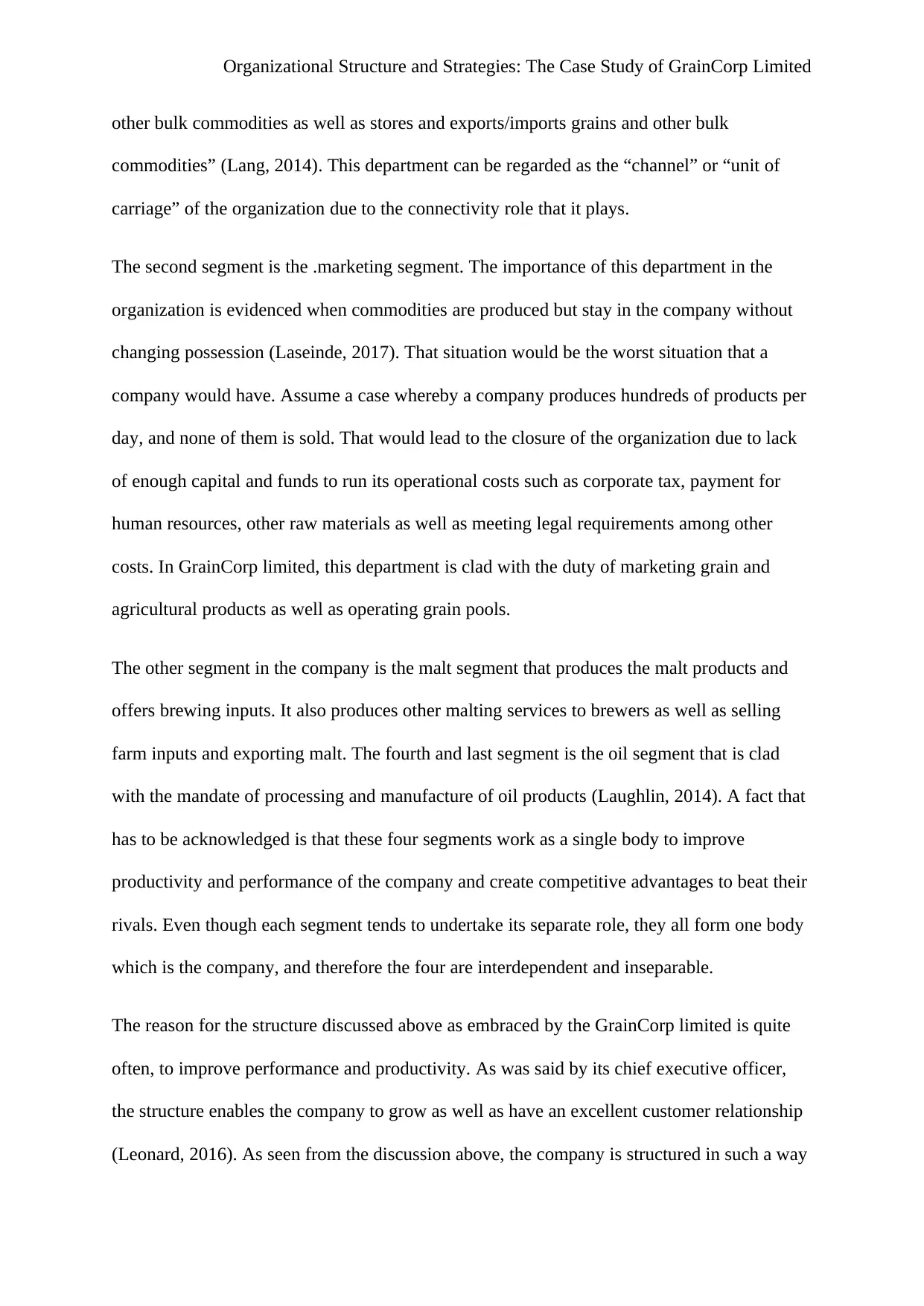
Organizational Structure and Strategies: The Case Study of GrainCorp Limited
other bulk commodities as well as stores and exports/imports grains and other bulk
commodities” (Lang, 2014). This department can be regarded as the “channel” or “unit of
carriage” of the organization due to the connectivity role that it plays.
The second segment is the .marketing segment. The importance of this department in the
organization is evidenced when commodities are produced but stay in the company without
changing possession (Laseinde, 2017). That situation would be the worst situation that a
company would have. Assume a case whereby a company produces hundreds of products per
day, and none of them is sold. That would lead to the closure of the organization due to lack
of enough capital and funds to run its operational costs such as corporate tax, payment for
human resources, other raw materials as well as meeting legal requirements among other
costs. In GrainCorp limited, this department is clad with the duty of marketing grain and
agricultural products as well as operating grain pools.
The other segment in the company is the malt segment that produces the malt products and
offers brewing inputs. It also produces other malting services to brewers as well as selling
farm inputs and exporting malt. The fourth and last segment is the oil segment that is clad
with the mandate of processing and manufacture of oil products (Laughlin, 2014). A fact that
has to be acknowledged is that these four segments work as a single body to improve
productivity and performance of the company and create competitive advantages to beat their
rivals. Even though each segment tends to undertake its separate role, they all form one body
which is the company, and therefore the four are interdependent and inseparable.
The reason for the structure discussed above as embraced by the GrainCorp limited is quite
often, to improve performance and productivity. As was said by its chief executive officer,
the structure enables the company to grow as well as have an excellent customer relationship
(Leonard, 2016). As seen from the discussion above, the company is structured in such a way
other bulk commodities as well as stores and exports/imports grains and other bulk
commodities” (Lang, 2014). This department can be regarded as the “channel” or “unit of
carriage” of the organization due to the connectivity role that it plays.
The second segment is the .marketing segment. The importance of this department in the
organization is evidenced when commodities are produced but stay in the company without
changing possession (Laseinde, 2017). That situation would be the worst situation that a
company would have. Assume a case whereby a company produces hundreds of products per
day, and none of them is sold. That would lead to the closure of the organization due to lack
of enough capital and funds to run its operational costs such as corporate tax, payment for
human resources, other raw materials as well as meeting legal requirements among other
costs. In GrainCorp limited, this department is clad with the duty of marketing grain and
agricultural products as well as operating grain pools.
The other segment in the company is the malt segment that produces the malt products and
offers brewing inputs. It also produces other malting services to brewers as well as selling
farm inputs and exporting malt. The fourth and last segment is the oil segment that is clad
with the mandate of processing and manufacture of oil products (Laughlin, 2014). A fact that
has to be acknowledged is that these four segments work as a single body to improve
productivity and performance of the company and create competitive advantages to beat their
rivals. Even though each segment tends to undertake its separate role, they all form one body
which is the company, and therefore the four are interdependent and inseparable.
The reason for the structure discussed above as embraced by the GrainCorp limited is quite
often, to improve performance and productivity. As was said by its chief executive officer,
the structure enables the company to grow as well as have an excellent customer relationship
(Leonard, 2016). As seen from the discussion above, the company is structured in such a way
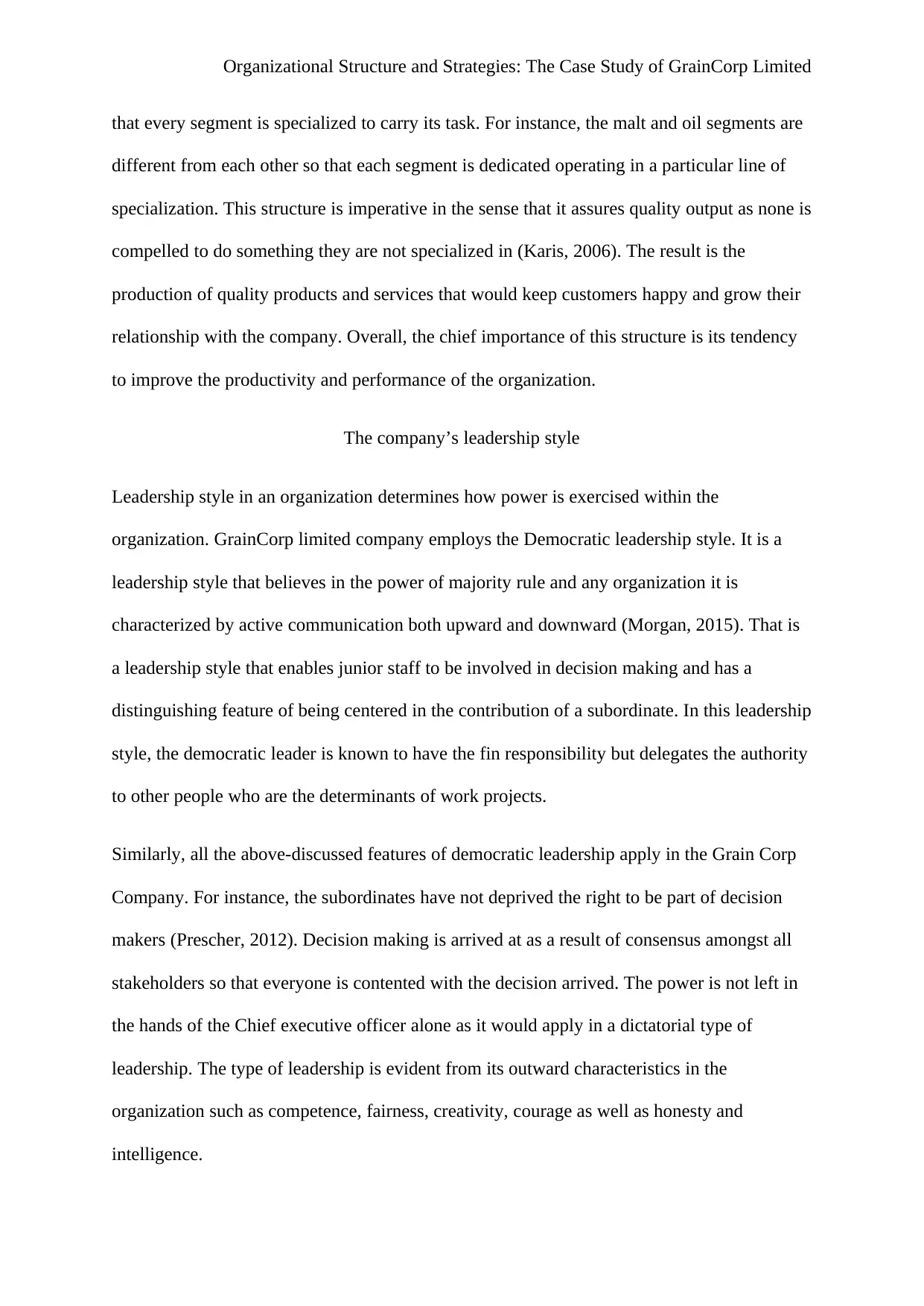
Organizational Structure and Strategies: The Case Study of GrainCorp Limited
that every segment is specialized to carry its task. For instance, the malt and oil segments are
different from each other so that each segment is dedicated operating in a particular line of
specialization. This structure is imperative in the sense that it assures quality output as none is
compelled to do something they are not specialized in (Karis, 2006). The result is the
production of quality products and services that would keep customers happy and grow their
relationship with the company. Overall, the chief importance of this structure is its tendency
to improve the productivity and performance of the organization.
The company’s leadership style
Leadership style in an organization determines how power is exercised within the
organization. GrainCorp limited company employs the Democratic leadership style. It is a
leadership style that believes in the power of majority rule and any organization it is
characterized by active communication both upward and downward (Morgan, 2015). That is
a leadership style that enables junior staff to be involved in decision making and has a
distinguishing feature of being centered in the contribution of a subordinate. In this leadership
style, the democratic leader is known to have the fin responsibility but delegates the authority
to other people who are the determinants of work projects.
Similarly, all the above-discussed features of democratic leadership apply in the Grain Corp
Company. For instance, the subordinates have not deprived the right to be part of decision
makers (Prescher, 2012). Decision making is arrived at as a result of consensus amongst all
stakeholders so that everyone is contented with the decision arrived. The power is not left in
the hands of the Chief executive officer alone as it would apply in a dictatorial type of
leadership. The type of leadership is evident from its outward characteristics in the
organization such as competence, fairness, creativity, courage as well as honesty and
intelligence.
that every segment is specialized to carry its task. For instance, the malt and oil segments are
different from each other so that each segment is dedicated operating in a particular line of
specialization. This structure is imperative in the sense that it assures quality output as none is
compelled to do something they are not specialized in (Karis, 2006). The result is the
production of quality products and services that would keep customers happy and grow their
relationship with the company. Overall, the chief importance of this structure is its tendency
to improve the productivity and performance of the organization.
The company’s leadership style
Leadership style in an organization determines how power is exercised within the
organization. GrainCorp limited company employs the Democratic leadership style. It is a
leadership style that believes in the power of majority rule and any organization it is
characterized by active communication both upward and downward (Morgan, 2015). That is
a leadership style that enables junior staff to be involved in decision making and has a
distinguishing feature of being centered in the contribution of a subordinate. In this leadership
style, the democratic leader is known to have the fin responsibility but delegates the authority
to other people who are the determinants of work projects.
Similarly, all the above-discussed features of democratic leadership apply in the Grain Corp
Company. For instance, the subordinates have not deprived the right to be part of decision
makers (Prescher, 2012). Decision making is arrived at as a result of consensus amongst all
stakeholders so that everyone is contented with the decision arrived. The power is not left in
the hands of the Chief executive officer alone as it would apply in a dictatorial type of
leadership. The type of leadership is evident from its outward characteristics in the
organization such as competence, fairness, creativity, courage as well as honesty and
intelligence.
⊘ This is a preview!⊘
Do you want full access?
Subscribe today to unlock all pages.

Trusted by 1+ million students worldwide
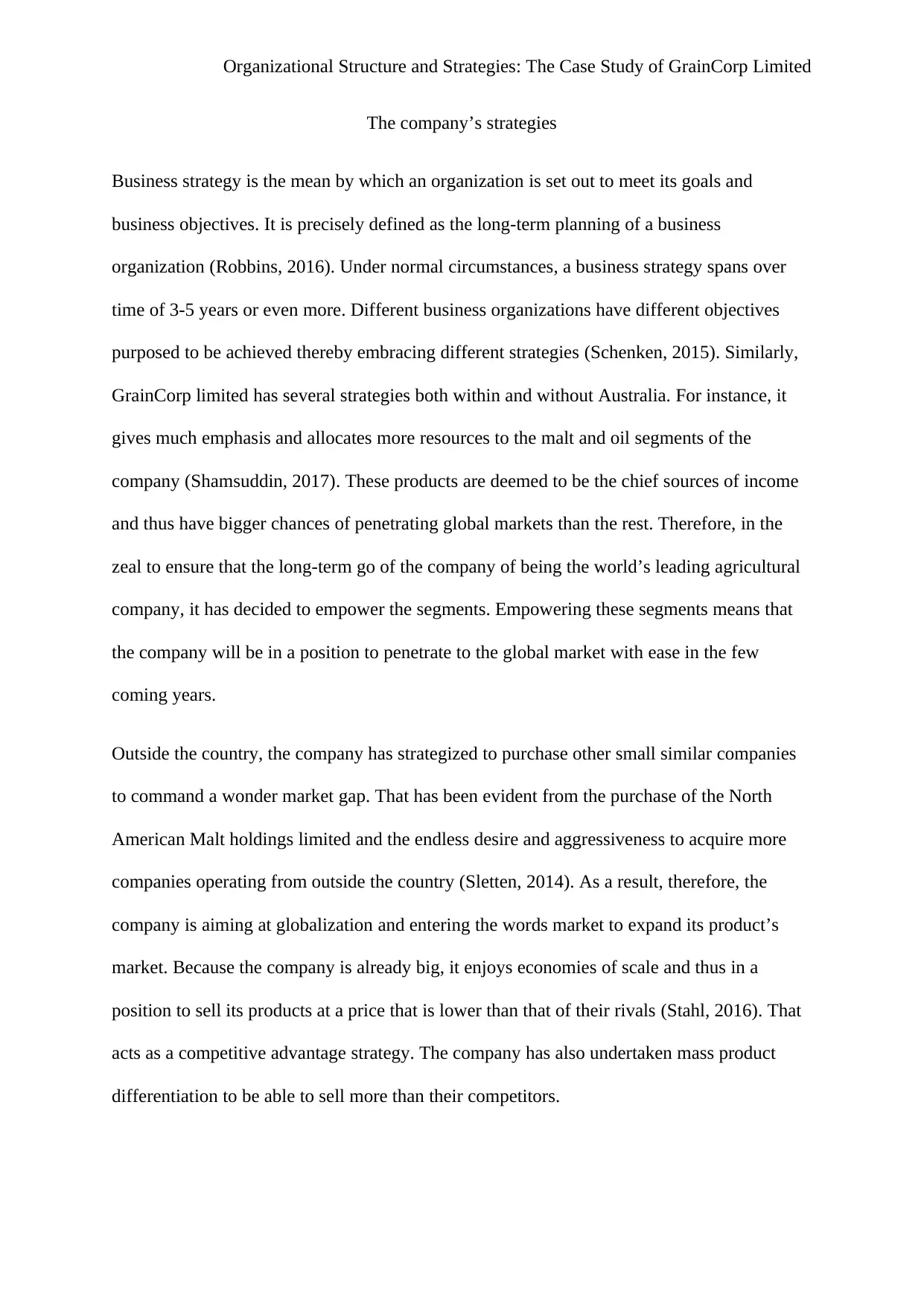
Organizational Structure and Strategies: The Case Study of GrainCorp Limited
The company’s strategies
Business strategy is the mean by which an organization is set out to meet its goals and
business objectives. It is precisely defined as the long-term planning of a business
organization (Robbins, 2016). Under normal circumstances, a business strategy spans over
time of 3-5 years or even more. Different business organizations have different objectives
purposed to be achieved thereby embracing different strategies (Schenken, 2015). Similarly,
GrainCorp limited has several strategies both within and without Australia. For instance, it
gives much emphasis and allocates more resources to the malt and oil segments of the
company (Shamsuddin, 2017). These products are deemed to be the chief sources of income
and thus have bigger chances of penetrating global markets than the rest. Therefore, in the
zeal to ensure that the long-term go of the company of being the world’s leading agricultural
company, it has decided to empower the segments. Empowering these segments means that
the company will be in a position to penetrate to the global market with ease in the few
coming years.
Outside the country, the company has strategized to purchase other small similar companies
to command a wonder market gap. That has been evident from the purchase of the North
American Malt holdings limited and the endless desire and aggressiveness to acquire more
companies operating from outside the country (Sletten, 2014). As a result, therefore, the
company is aiming at globalization and entering the words market to expand its product’s
market. Because the company is already big, it enjoys economies of scale and thus in a
position to sell its products at a price that is lower than that of their rivals (Stahl, 2016). That
acts as a competitive advantage strategy. The company has also undertaken mass product
differentiation to be able to sell more than their competitors.
The company’s strategies
Business strategy is the mean by which an organization is set out to meet its goals and
business objectives. It is precisely defined as the long-term planning of a business
organization (Robbins, 2016). Under normal circumstances, a business strategy spans over
time of 3-5 years or even more. Different business organizations have different objectives
purposed to be achieved thereby embracing different strategies (Schenken, 2015). Similarly,
GrainCorp limited has several strategies both within and without Australia. For instance, it
gives much emphasis and allocates more resources to the malt and oil segments of the
company (Shamsuddin, 2017). These products are deemed to be the chief sources of income
and thus have bigger chances of penetrating global markets than the rest. Therefore, in the
zeal to ensure that the long-term go of the company of being the world’s leading agricultural
company, it has decided to empower the segments. Empowering these segments means that
the company will be in a position to penetrate to the global market with ease in the few
coming years.
Outside the country, the company has strategized to purchase other small similar companies
to command a wonder market gap. That has been evident from the purchase of the North
American Malt holdings limited and the endless desire and aggressiveness to acquire more
companies operating from outside the country (Sletten, 2014). As a result, therefore, the
company is aiming at globalization and entering the words market to expand its product’s
market. Because the company is already big, it enjoys economies of scale and thus in a
position to sell its products at a price that is lower than that of their rivals (Stahl, 2016). That
acts as a competitive advantage strategy. The company has also undertaken mass product
differentiation to be able to sell more than their competitors.
Paraphrase This Document
Need a fresh take? Get an instant paraphrase of this document with our AI Paraphraser
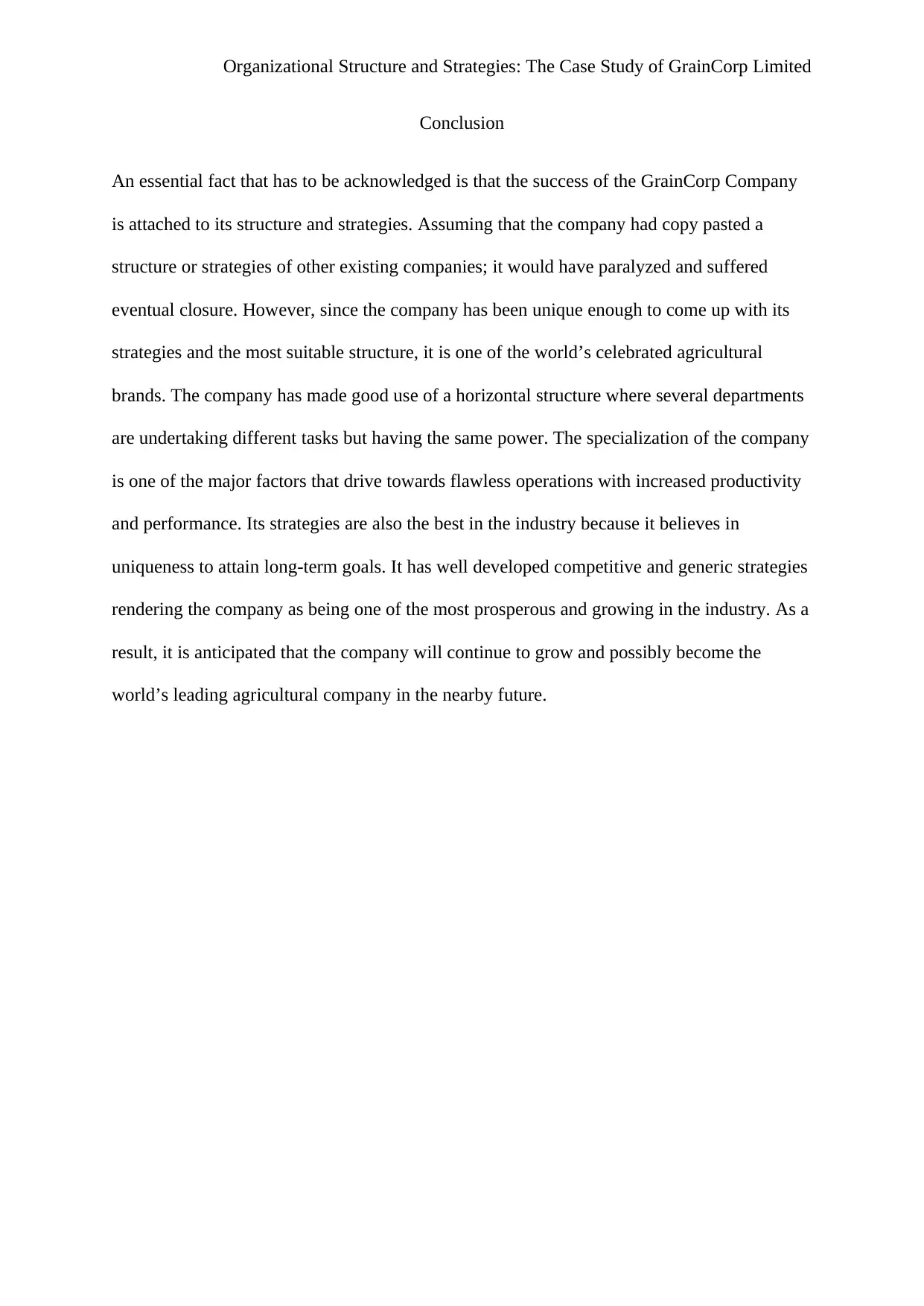
Organizational Structure and Strategies: The Case Study of GrainCorp Limited
Conclusion
An essential fact that has to be acknowledged is that the success of the GrainCorp Company
is attached to its structure and strategies. Assuming that the company had copy pasted a
structure or strategies of other existing companies; it would have paralyzed and suffered
eventual closure. However, since the company has been unique enough to come up with its
strategies and the most suitable structure, it is one of the world’s celebrated agricultural
brands. The company has made good use of a horizontal structure where several departments
are undertaking different tasks but having the same power. The specialization of the company
is one of the major factors that drive towards flawless operations with increased productivity
and performance. Its strategies are also the best in the industry because it believes in
uniqueness to attain long-term goals. It has well developed competitive and generic strategies
rendering the company as being one of the most prosperous and growing in the industry. As a
result, it is anticipated that the company will continue to grow and possibly become the
world’s leading agricultural company in the nearby future.
Conclusion
An essential fact that has to be acknowledged is that the success of the GrainCorp Company
is attached to its structure and strategies. Assuming that the company had copy pasted a
structure or strategies of other existing companies; it would have paralyzed and suffered
eventual closure. However, since the company has been unique enough to come up with its
strategies and the most suitable structure, it is one of the world’s celebrated agricultural
brands. The company has made good use of a horizontal structure where several departments
are undertaking different tasks but having the same power. The specialization of the company
is one of the major factors that drive towards flawless operations with increased productivity
and performance. Its strategies are also the best in the industry because it believes in
uniqueness to attain long-term goals. It has well developed competitive and generic strategies
rendering the company as being one of the most prosperous and growing in the industry. As a
result, it is anticipated that the company will continue to grow and possibly become the
world’s leading agricultural company in the nearby future.
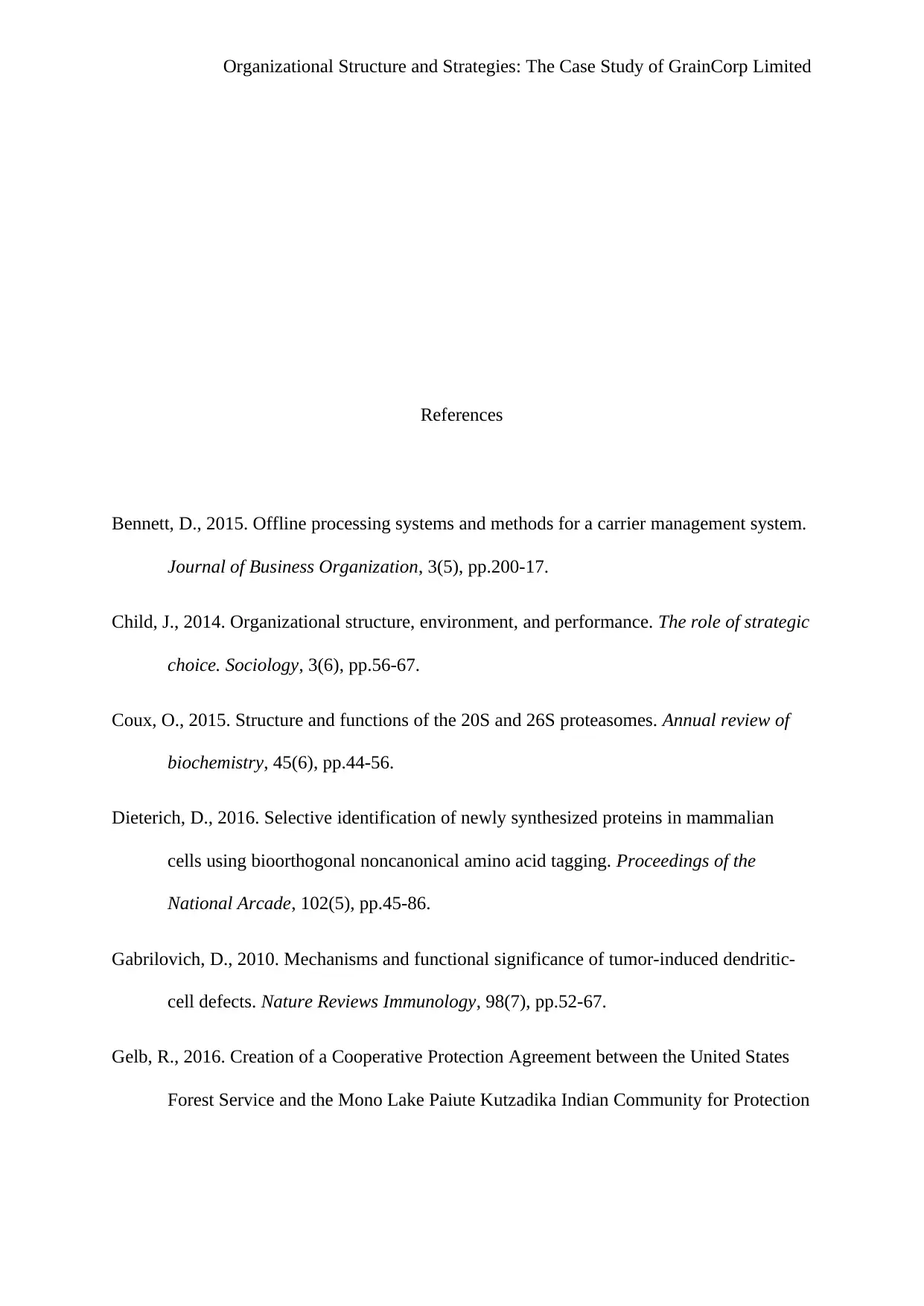
Organizational Structure and Strategies: The Case Study of GrainCorp Limited
References
Bennett, D., 2015. Offline processing systems and methods for a carrier management system.
Journal of Business Organization, 3(5), pp.200-17.
Child, J., 2014. Organizational structure, environment, and performance. The role of strategic
choice. Sociology, 3(6), pp.56-67.
Coux, O., 2015. Structure and functions of the 20S and 26S proteasomes. Annual review of
biochemistry, 45(6), pp.44-56.
Dieterich, D., 2016. Selective identification of newly synthesized proteins in mammalian
cells using bioorthogonal noncanonical amino acid tagging. Proceedings of the
National Arcade, 102(5), pp.45-86.
Gabrilovich, D., 2010. Mechanisms and functional significance of tumor-induced dendritic-
cell defects. Nature Reviews Immunology, 98(7), pp.52-67.
Gelb, R., 2016. Creation of a Cooperative Protection Agreement between the United States
Forest Service and the Mono Lake Paiute Kutzadika Indian Community for Protection
References
Bennett, D., 2015. Offline processing systems and methods for a carrier management system.
Journal of Business Organization, 3(5), pp.200-17.
Child, J., 2014. Organizational structure, environment, and performance. The role of strategic
choice. Sociology, 3(6), pp.56-67.
Coux, O., 2015. Structure and functions of the 20S and 26S proteasomes. Annual review of
biochemistry, 45(6), pp.44-56.
Dieterich, D., 2016. Selective identification of newly synthesized proteins in mammalian
cells using bioorthogonal noncanonical amino acid tagging. Proceedings of the
National Arcade, 102(5), pp.45-86.
Gabrilovich, D., 2010. Mechanisms and functional significance of tumor-induced dendritic-
cell defects. Nature Reviews Immunology, 98(7), pp.52-67.
Gelb, R., 2016. Creation of a Cooperative Protection Agreement between the United States
Forest Service and the Mono Lake Paiute Kutzadika Indian Community for Protection
⊘ This is a preview!⊘
Do you want full access?
Subscribe today to unlock all pages.

Trusted by 1+ million students worldwide
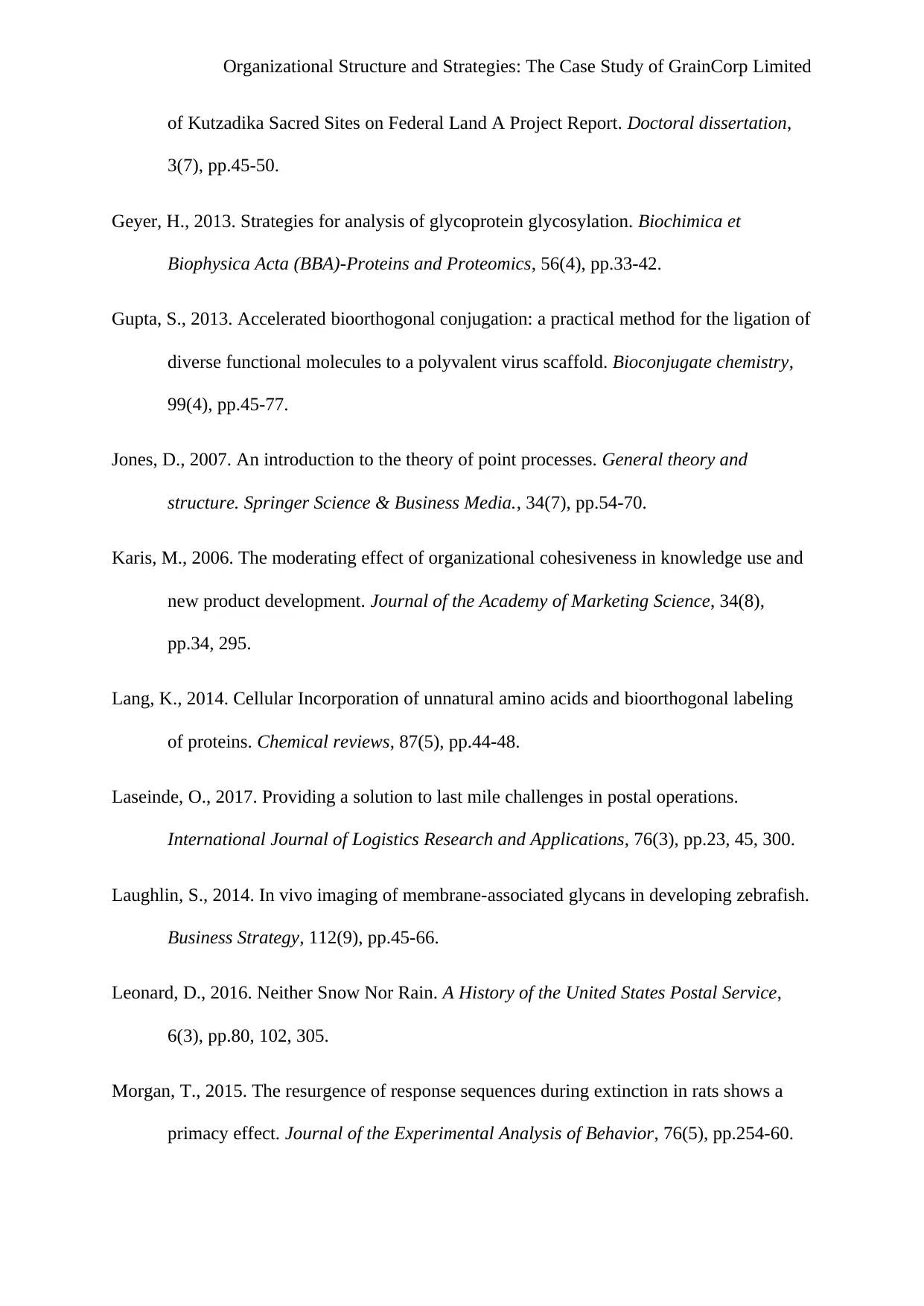
Organizational Structure and Strategies: The Case Study of GrainCorp Limited
of Kutzadika Sacred Sites on Federal Land A Project Report. Doctoral dissertation,
3(7), pp.45-50.
Geyer, H., 2013. Strategies for analysis of glycoprotein glycosylation. Biochimica et
Biophysica Acta (BBA)-Proteins and Proteomics, 56(4), pp.33-42.
Gupta, S., 2013. Accelerated bioorthogonal conjugation: a practical method for the ligation of
diverse functional molecules to a polyvalent virus scaffold. Bioconjugate chemistry,
99(4), pp.45-77.
Jones, D., 2007. An introduction to the theory of point processes. General theory and
structure. Springer Science & Business Media., 34(7), pp.54-70.
Karis, M., 2006. The moderating effect of organizational cohesiveness in knowledge use and
new product development. Journal of the Academy of Marketing Science, 34(8),
pp.34, 295.
Lang, K., 2014. Cellular Incorporation of unnatural amino acids and bioorthogonal labeling
of proteins. Chemical reviews, 87(5), pp.44-48.
Laseinde, O., 2017. Providing a solution to last mile challenges in postal operations.
International Journal of Logistics Research and Applications, 76(3), pp.23, 45, 300.
Laughlin, S., 2014. In vivo imaging of membrane-associated glycans in developing zebrafish.
Business Strategy, 112(9), pp.45-66.
Leonard, D., 2016. Neither Snow Nor Rain. A History of the United States Postal Service,
6(3), pp.80, 102, 305.
Morgan, T., 2015. The resurgence of response sequences during extinction in rats shows a
primacy effect. Journal of the Experimental Analysis of Behavior, 76(5), pp.254-60.
of Kutzadika Sacred Sites on Federal Land A Project Report. Doctoral dissertation,
3(7), pp.45-50.
Geyer, H., 2013. Strategies for analysis of glycoprotein glycosylation. Biochimica et
Biophysica Acta (BBA)-Proteins and Proteomics, 56(4), pp.33-42.
Gupta, S., 2013. Accelerated bioorthogonal conjugation: a practical method for the ligation of
diverse functional molecules to a polyvalent virus scaffold. Bioconjugate chemistry,
99(4), pp.45-77.
Jones, D., 2007. An introduction to the theory of point processes. General theory and
structure. Springer Science & Business Media., 34(7), pp.54-70.
Karis, M., 2006. The moderating effect of organizational cohesiveness in knowledge use and
new product development. Journal of the Academy of Marketing Science, 34(8),
pp.34, 295.
Lang, K., 2014. Cellular Incorporation of unnatural amino acids and bioorthogonal labeling
of proteins. Chemical reviews, 87(5), pp.44-48.
Laseinde, O., 2017. Providing a solution to last mile challenges in postal operations.
International Journal of Logistics Research and Applications, 76(3), pp.23, 45, 300.
Laughlin, S., 2014. In vivo imaging of membrane-associated glycans in developing zebrafish.
Business Strategy, 112(9), pp.45-66.
Leonard, D., 2016. Neither Snow Nor Rain. A History of the United States Postal Service,
6(3), pp.80, 102, 305.
Morgan, T., 2015. The resurgence of response sequences during extinction in rats shows a
primacy effect. Journal of the Experimental Analysis of Behavior, 76(5), pp.254-60.
Paraphrase This Document
Need a fresh take? Get an instant paraphrase of this document with our AI Paraphraser
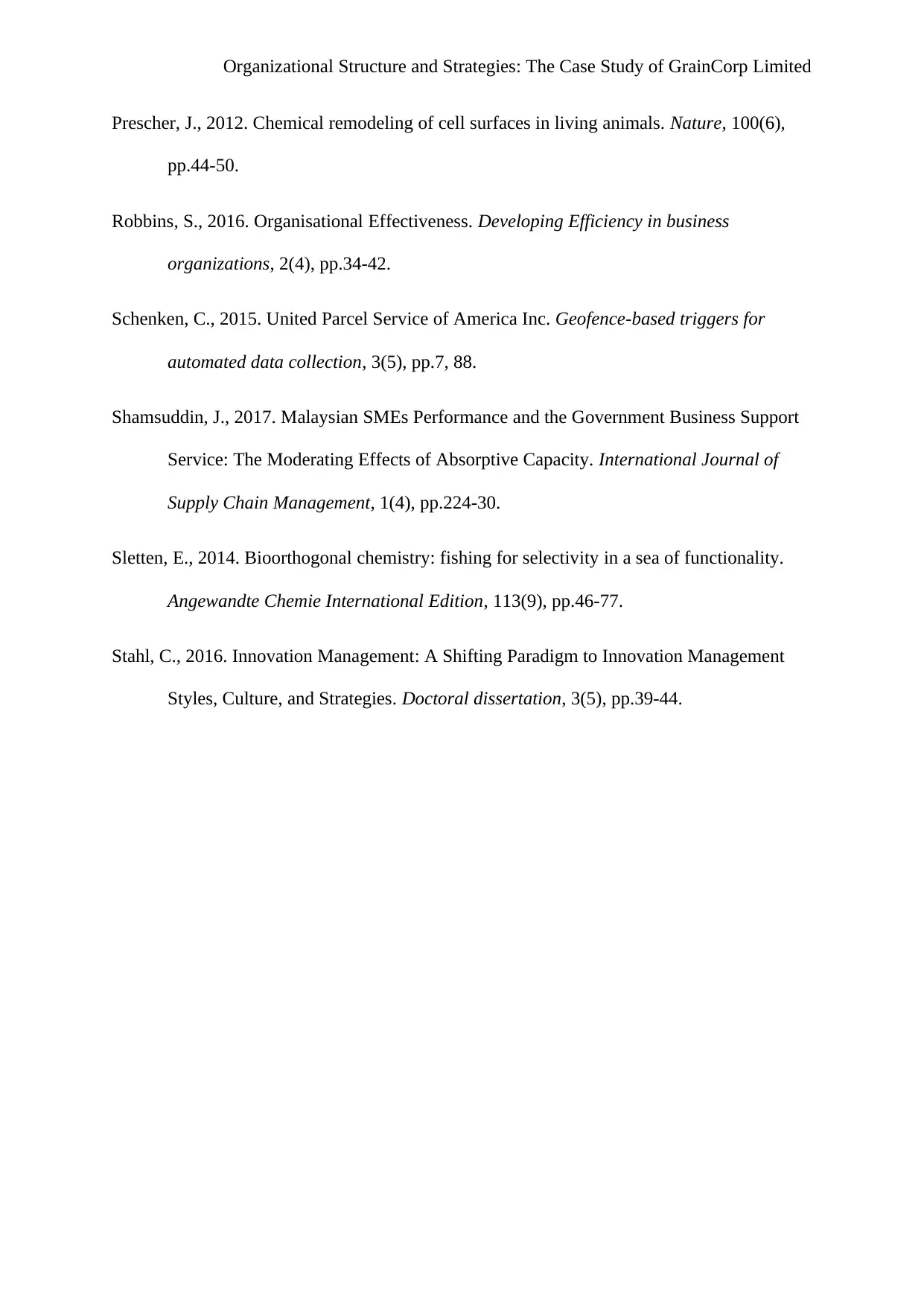
Organizational Structure and Strategies: The Case Study of GrainCorp Limited
Prescher, J., 2012. Chemical remodeling of cell surfaces in living animals. Nature, 100(6),
pp.44-50.
Robbins, S., 2016. Organisational Effectiveness. Developing Efficiency in business
organizations, 2(4), pp.34-42.
Schenken, C., 2015. United Parcel Service of America Inc. Geofence-based triggers for
automated data collection, 3(5), pp.7, 88.
Shamsuddin, J., 2017. Malaysian SMEs Performance and the Government Business Support
Service: The Moderating Effects of Absorptive Capacity. International Journal of
Supply Chain Management, 1(4), pp.224-30.
Sletten, E., 2014. Bioorthogonal chemistry: fishing for selectivity in a sea of functionality.
Angewandte Chemie International Edition, 113(9), pp.46-77.
Stahl, C., 2016. Innovation Management: A Shifting Paradigm to Innovation Management
Styles, Culture, and Strategies. Doctoral dissertation, 3(5), pp.39-44.
Prescher, J., 2012. Chemical remodeling of cell surfaces in living animals. Nature, 100(6),
pp.44-50.
Robbins, S., 2016. Organisational Effectiveness. Developing Efficiency in business
organizations, 2(4), pp.34-42.
Schenken, C., 2015. United Parcel Service of America Inc. Geofence-based triggers for
automated data collection, 3(5), pp.7, 88.
Shamsuddin, J., 2017. Malaysian SMEs Performance and the Government Business Support
Service: The Moderating Effects of Absorptive Capacity. International Journal of
Supply Chain Management, 1(4), pp.224-30.
Sletten, E., 2014. Bioorthogonal chemistry: fishing for selectivity in a sea of functionality.
Angewandte Chemie International Edition, 113(9), pp.46-77.
Stahl, C., 2016. Innovation Management: A Shifting Paradigm to Innovation Management
Styles, Culture, and Strategies. Doctoral dissertation, 3(5), pp.39-44.
1 out of 11
Related Documents
Your All-in-One AI-Powered Toolkit for Academic Success.
+13062052269
info@desklib.com
Available 24*7 on WhatsApp / Email
![[object Object]](/_next/static/media/star-bottom.7253800d.svg)
Unlock your academic potential
Copyright © 2020–2025 A2Z Services. All Rights Reserved. Developed and managed by ZUCOL.





